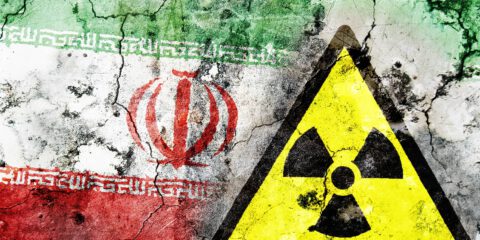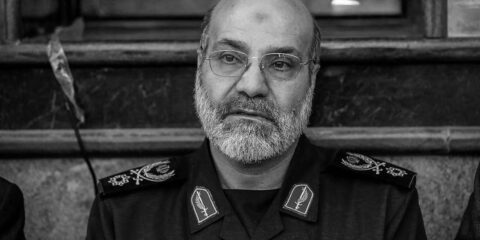In his recent “State of the Nation” address, Russian President Putin unveiled six new strategic, advanced weapon systems. The important point about these impressive weapons is their ability to penetrate the global missile defense system that according to Putin is being deployed by the United States. But, such a system does not exist and is not even being planned. It is not surprising that the US responded to Putin’s speech with indifference. Putin’s speech reveals, more than anything else, the continuing Russian trauma from the “Star Wars” initiative of President Reagan.
On March 1, Russian President Vladimir Putin delivered a “State of the Nation” address to an audience that included members of the Duma (the Parliament) of the Russian Federation, members of the Supreme Court of Russia, government ministers and other senior officials. Most of the speech dwelled on economic and social issues; and both Putin and the audience seemed bored by it. But the last part of the speech was very different. With a gleam in his eye, Putin presented a series of new strategic weapon systems, including ballistic missiles, cruise missiles and directed-energy weapons. The presentation was accompanied by video clips and animation and was received with enthusiasm by the audience. Putin finished his speech by saying: “Everything that [the West] tried to prevent… has already happened. No one has managed to restrain Russia!” and the audience cheered. In the background flew the flag of the Russian Federation, which bears the double-headed eagle of the czars to the melody of the Soviet Union’s national anthem during Stalin’s day. (That is now the Russian national anthem albeit with new lyrics). This was a flawless show of historical continuity and a declaration that the Russian colossus in its various incarnations has reemerged in an upgraded 21st century digital version.
What attracted the attention of the media and immediately grabbed headlines worldwide was the detailed and loving description, accompanied by video clips, of six new weapon systems. First, was an intercontinental ballistic missile with a sufficient range to attack the US from “underneath”, namely by way of the South Pole. Second, a cruise missile with a nuclear propulsion system, which provides it with an unlimited range and as a result an ability to detour around defense systems, to circle the globe and to attack the US from unexpected directions. Third, was an unmanned mini-stealth submarine that cannot be protected against, with the ability to attack any ship and any port in the world. Fourth, an air-to-ground missile with a range of 2000 km. that can travels at speeds five time faster than the speed of sound and has the ability to change direction and thus avoid interception. Fifth, a ballistic missile that releases a hypersonic glide vehicle with an intercontinental range that can “skip” along the edge of the stratosphere like a flat stone skipping from a pond’s surface, making it immune to air and missile defense systems. And sixth, a powerful mobile laser system that apparently can “blind” spy satellites that are helping to locate targets for a missile defense system and thus disrupt their activity.
The common denominator of these systems is the ability to evade or disrupt defense systems and primarily those that are meant to intercept missiles. The current generation of missile defense systems – from the American one that is protecting the Western US from North Korean missiles to the Israeli Arrow and Iron Dome systems – is designed to stop ballistic missiles that have predictable trajectories that allow predicting where and when they will land and therefore where and when to intercept them. The Russian weapons unveiled by Putin travel in trajectories that cannot be predicted and therefore the current generation of defense systems will be helpless against them. The laser weapon that was presented is apparently meant to prevent early detection of these missiles by spy satellites and thus make it even more difficult to intercept them.
The common denominator of these systems is the ability to penetrate, evade or disrupt the US global defense system that Putin says is currently being deployed around Russian borders.
Putin did not hide the rationale for those awesome new weapons. Allegedly the US is developing a global defense system against ballistic missiles that could protect the US and its allies against a Russian nuclear attack, thus upsetting the global balance of power. Russia’s new strategic systems are designed to penetrate through this global defense system thus preserving Russia’s capability to deliver a nuclear “second strike” in response to any nuclear and non-nuclear attack on Russia and its allies. This, in Putin’s view will restore the global nuclear balance and ensure world peace.
It is reasonable to assume that the news that the US is developing a global ballistic missile defense system caught the US administration by surprise, since it is not aware of such a system’s existence. In actuality, the US has deployed a limited capability strategic defense system in California and Alaska against the threat of North Korean ICBM’s. This system will be able to intercept no more than 22 warheads, which is about one-third of one percent of the number of Russia’s nuclear warheads. The size of the American system was intentionally limited so as not to threaten Russia’s or China’s second-strike capability. The US continues to adhere to a doctrine of deterrence rather than defense regarding the other major nuclear powers. The days of “Star Wars” and the Strategic Defense Initiative are long gone.
The US nuclear strategy continues to be based on deterrence rather than defense, hence the US administration’s indifference to Putin’s speech.
In the conventional domain, the US is developing and deploying an array of tactical defense systems that are designed to protect its forces deployed around the world as well as its allies (such as Japan and South Korea) against relatively short or theater range conventional missiles. It has supplied such systems to its allies, such as Saudi Arabia and the Gulf emirates for protection against Iranian missiles. None of these systems are designed to intercept intercontinental ballistic missiles nor are they capable of doing so with any effect. The Iranian threat is also the reason for NATO’s European defense system, which is based on naval tactical defenses systems that do not have the ability to intercept intercontinental ballistic missiles launched from Russia. The US intends to invest about $1.2 trillion in the rejuvenation of its nuclear strike force in coming decades and this includes the development of a new generation of intercontinental ballistic missiles, development of a new strategic bomber with stealth capability and the launch of 12 new nuclear submarines. The investment in a missile defense system will remain relatively low and there is currently no plan to increase it. From every practical viewpoint, the US strategy with respect to Russia and China has been and is still based on deterrence rather than defense. The security of the US will continue to rely on its capability to retaliate against a first nuclear strike rather than to intercept the missiles of the opponent. Thus, the reaction of the US administration to Putin’s saber-rattling could be described as a shrug. Russia’s new strategic arsenal – as impressive as it is technologically– essentially constitutes a shot in the dark, a solution looking for a problem. More than anything, Putin’s “missile speech” reveals more about the way in which modern Russia interprets its recent history as well as its future aspirations. To perceive it in context, one travel back in time to the Cold War era with its Anti-Ballistic Missile (ABM) treaty and President Reagan’s “Star Wars” initiative.
During the 1960s, the two superpowers raced each other to develop and deploy ever more deadly intercontinental ballistic missiles (ICBMs). Concurrently they were also engaged in a much less advertised but no less frantic race to develop strategic missile defense systems. The first successful interception of a ballistic missile was achieved in 1961 by the Soviet Union, but a year later the US caught up and achieved its own successful interception. By the late 1960s both superpowers began to deploy their first-generation operational missile defense systems which were necessarily clumsy and expensive due to the limited technology in those days. The introduction of strategic missile defense drove the arms race to a fever pitch, and the economic burden was starting to bite on both sides. This compelled the two contenders to seek a diplomatic accommodation that would slow the arms race and reduce its cost. One of the results was the ABM Treaty of 1972 that committed both sides to build no more than two missile defense sites each and to refrain from fully developing more advanced defense systems. The US built one defensive site to protect some of its ICBM launch sites while the USSR deployed one battery to defend Moscow. No further defense sites were ever built, and the US one was soon dismantled. The Moscow defense site however still exists, and has been upgraded over the years.
The ABM Treaty was perceived by the USSR as a major diplomatic achievement and as a stabilizing factor in the Cold War. From its viewpoint, the treaty recognized its status as an equal to the US in the shaping of global affairs. However, the election of President Reagan in 1980 threatened this achievement. Reagan, who strove to end the Cold War was persuaded by Edward Teller, the famous physicist and “father of the hydrogen bomb”, to declare a strategic defense initiative whose goal was the perfection of an impenetrable defense system against intercontinental ballistic missiles, thereby eliminating Soviet Union’s first strike threat. This initiative, which was quickly dubbed “Star Wars”, was vociferously opposed by the scientific community and liberal circles in the US and Europe. In the Soviet Union, the “Star Wars” initiative came as a shock to the leadership. Although the scientific community of the Soviet Union quickly realized that “Star Wars” was not workable, the political and military leadership, still smarting from the humiliating loss of the race to the Moon was convinced that there was no technological wizardry that the US couldn’t do, and that it might make “Star Wars” work. This would nullify the strategic parity achieved by the ABM Treaty, degrading the Soviet Union back to the status of a second-rate power. The Soviet military establishment demanded authority and resources to develop a new generation of ballistic missiles that could penetrate through the putative US missile shield, as well to building a Soviet “Star Wars” of their own. However, the declining economy of the Soviet Union could not afford the massive expenditures required to accomplish this. Mikhail Gorbachev who had been elected in 1985 by his colleagues as the supreme ruler of the frail Soviet empire refused the demands of his army, proposing instead to President Reagan the “deal of his life”, namely the elimination of all nuclear ballistic missiles of both sides, which would bring an end to the nuclear threat on the US. In return, Gorbachev demanded the cancellation of “Star Wars.” Reagan turned it down and by this sealed the fate of the Soviet Union and that of Mikhail Gorbachev himself. During the subsequent decade, when it appeared that the ballistic missiles and nuclear weapon programs of North Korea were liable to pose a threat to the US, President Bush cancelled the ABM Treaty and ordered the deployment of a limited defense system on the West Coast and in Alaska to defend against North Korean missiles, as briefly described above.
The Russian investment in missiles that can penetrate a defense system is evidence of Russia’s trauma from the days of President Reagan’s “Star Wars” initiative, more than anything else.
The debate about the contribution of “Star Wars” to the demise of the Soviet Union still persists. Immediately after the dissolution of the USSR numerous Western analysts as well as numerous Russian ones credited “Star Wars” as the decisive factor in this historic event. Over time, the voices of liberal commentators in the West who have resented “Star Wars” from the start have gradually grown dominant. According to them, the fall of the Soviet Union had nothing to do with “Star Wars” and everything to do with tectonic social and economic movement within the Soviet Union, such as ethnic rivalries and the demand for human rights. One such commentator is Ken Follet a world-famous author and member of the British Labour Party. In his recent docu-historical novel “Edge of Eternity”, Follet attributes the fall of the Soviet Union to the persistent campaign of Russian and Polish human rights activists and dismisses the claim that “Star Wars” had anything to do with it as a myth invented by conservative politicians and intelligence agencies in the US for self-aggrandizement.
It seems that contemporary Russia sees things differently. Contrary to Western trivialization, “Star Wars” apparently plays a lead role in how Russia interprets the story of the demise of its predecessor as can be surmised from President Putin’s speech. Although Putin did not mention “Star Wars” by name, it clearly cast its shadow on his strategic thinking. As mentioned above, Putin’s justification for the development of his new systems was that “Star War” is back, albeit by a different name and the abrogation of the ABM Treaty was nothing but a move to launder it vis-a-vis US legislation. It is reasonable to assume that most, if not all, of the ideas for “evasion” or disruption of missile defense systems that were implemented in Russia’s new systems already were proposed by engineers in the Soviet Union to counter “Star Wars.” Although Putin took full credit for the new weapons by claiming that they were not legacy from the Soviet era, he conceded that “we used several ideas of our talented predecessors”. It is quit tempting to assume that the cutting-edge weapons flaunted by Putin were the modern incarnations of those rejected by Mikhail Gorbachev. More than 30 years on, Russia is finally countering President Reagan’s “Star Wars.” From the Western point of view, Russia’s new strategic systems are a shot in the dark. From Putin’s perspective, they constitute an appropriate Russian response to Reagan’s gauntlet, an erasure of the stinging insult of the Soviet Union’s collapse and a symbol of Russia’s restoration as a superpower with equal say in the management of world affairs. It can be assumed that from Putin’s perspective, the March 1 speech more than mere electioneering. Rather it was a historic declaration that marked the end of one era and the opening of a new one in Russian and global history.
The two sides are talking past one another. From Russia’s viewpoint, Putin’s speech was an expression of a well-thought-out and responsible policy. From Washington’s viewpoint, the speech was saber-rattling.
Notwithstanding the ingenious technology of the new strategic weapon systems presented in Putin’s speech, none of them violate the international treaties which Russia is obligated by. Despite the fears in Europe, Putin has not declared the nullification of the Intermediate-Range Nuclear Forces (INF) Treaty which had been inherited from the Gorbachev era. It seems that Putin’s policy, at least for the moment, is not to change the rules of the game but rather to continue the dialogue with the US and Europe on additional strategic arms control agreements that would – so he hopes – include missile defense projects, giving Russia a veto power over them. So far, the US has refused to negotiate missile defense with Russia. The prospects that Putin’s new weapons will compel the US to change its mind seem quite low, since they do not change the deterrence posture neither of the US nor of its nuclear allies. It appears that the two sides are talking past one another. From Russia’s viewpoint, Putin’s speech was an expression of a responsible and well-thought-out policy. From the West’s point of view, Putin’s speech was Cold War style saber-rattling. Hopefully, the hot winds blowing from the East will not turn into the freezing winds of a new Cold War.
JISS Policy Papers are published through the generosity of the Greg Rosshandler Family.
photo: Bigstock









 - בניית אתרים
- בניית אתרים